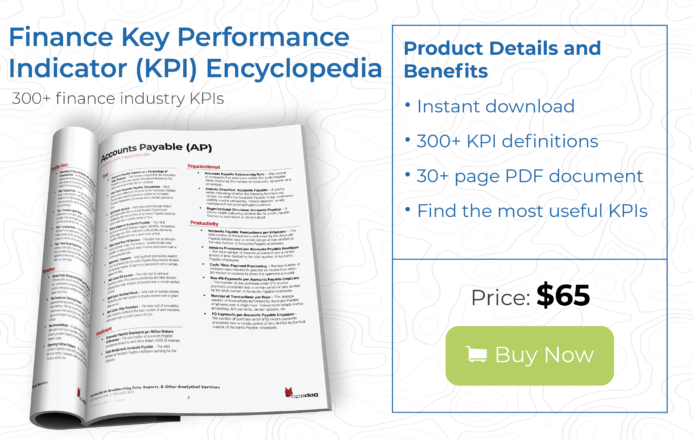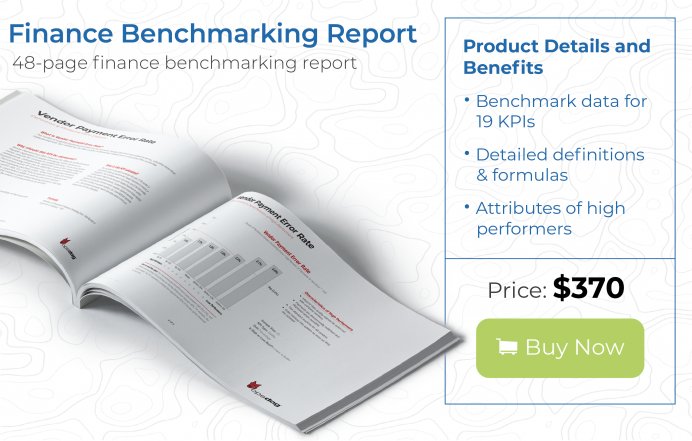Finance metrics, Key Performance Indicators (KPIs), benchmarks. All of these terms essentially mean the same thing: here is what you should measure in your Finance Department and here is how you are performing. Ultimately, for finance department managers, executives, and senior management, it’s always about the bottom line. Finance KPI that matter most to them always involve money – revenue, expense and net income. They get paid to count and analyze the flow of the mighty dollar through their businesses. This sounds glamorous and sexy – “vanity metrics.” In reality, however, the modern Finance Department more closely resembles a factory – one that produces financial reports with these dollar figures as an output at the end of an assembly line – than a giant money counter with dollar bills raining down from the ceiling.
If you take a step back and look at all the finance department labor required to create these financial report outputs from an operations perspective, much more must be measured in finance dashboards than just dollars generated by a company for it to run effectively and efficiently. Key Performance Indicators for the Finance Department, such as headcount metrics, work quality metrics, work volume metrics, cycle times and process-related metrics that measure group productivity as a whole, all contribute to the bottom line, just like revenue and sales-related figures do. These Key Performance Indicators for the Finance Department are additional pieces of the puzzle and are often overlooked by management: they appear tricky to measure and improve upon, especially in an environment that is primarily composed of knowledge work, where work products are “intangible widgets,” so to speak.
Let’s discuss a few operations-related KPIs for finance managers that are at the top of the list:
KPI for Finance Department Manager # 1: Days to Close
What is this Finance KPI Example?
This Key Performance Indicator for the Finance Department can be defined as the number of business days required to close the books and submit finalized financial reports to management and regulatory authorities at the end of the accounting period (monthly/quarterly/yearly), from the time the information necessary to close the books is gathered until management and the regulatory authorities receive the financial reports.
Why is this Finance KPI Example Important?
This Key Performance Indicator for the Finance Department defines the cycle time of the entire process from a departmental perspective. These closing periods range from one day for a small mom-and-pop finance shop all the way up to twenty-four days for the largest industry-lagging performers. The range is significant, but best-in-class Fortune 500 performers typically close in about five and a half days. Mid-level performers – the average shops – close the books in thirteen days. Set five days as your target if you want to be among the industry leaders. Want to see actual data for financial close cycles times? Click here..
KPI for Finance Department Manager # 2: Total Revenue per Finance Employee
What is this Finance KPI Example?
This Key Performance Indicator for the Finance Department can be defined as the total revenue generated by the company over a certain period of time, divided by the total number of Finance employees.
Why is this Finance KPI Example Important?
This Key Performance Indicator for the Finance Department is used to benchmark the headcount of a finance shop against comparable companies based on dollars-reconciled size so that managers can estimate how many people they need to process the work based on the volume of dollars coming through. For Fortune 500 businesses, an average leading finance function employee accounts for $19.6 million in revenue while an average lagging (not so good) performer comes in at around $7 million.
Want an encyclopedia of finance and accounting KPIs to select the best measurements for your finance operations? Be sure to grab the guide here…
KPI for Finance Department Manager # 3: Finance Staffing Ratio
What is this Finance KPI Example?
This Key Performance Indicator for the Finance Department can be defined as the division between the number of company-wide employees and the total number of Finance employees working for the company.
Why is this Finance KPI Example Important?
Believe it or not, a lot of the world’s biggest businesses have no idea how many people work in any given department. Entire consulting engagements are undertaken just to figure out an organizational structure and who is allocated to each group. Because finance is a non-revenue generating function, you want to make this ratio as high as possible without suffering performance issues. A low, or lagging, number for this finance KPI example indicates that the Finance Department is overstaffed. Look to combine redundant job roles and improve process efficiency to remedy this. On average, one finance employee supports 55 firm-wide employees.
KPI for Finance Department Manager # 4: Finance Report Error Rate
What is this Finance KPI Example?
This Key Performance Indicator for the Finance Department can be defined as the division between the number of financial reports that contain errors and the total number of financial reports produced over the same period of time, taken as a percentage.
Why is this Finance KPI Example Important?
A low error rate obviously means higher quality work by the Finance function. Financial reports riddled with errors create rework for financial analysts and reporting managers, and therefore increase the expense of the Finance function. Increased finance expense reduces net income for the entire business. More importantly, these errors can lead to misinformation and even problems with the SEC if inaccurate statements are posted.
Are you looking for finance operations benchmarks? Look no further…we have them…
KPI for Finance Department Manager # 5: Reports Produced per Finance Employee
What is this Finance KPI Example?
This Key Performance Indicator for the Finance Department can be defined as the number of reports created or managed by an individual finance employee for a given time period.
Why is this Finance KPI Example Important?
This is a classic productivity metric at the individual employee level. Tracking employee output is important for CFOs because, when coupled with quality metrics like the error rate listed above, it helps to identify high- and low-performing employees. CFO KPIs like this applied to an entire department make annual employee reviews 100% objective rather than relying on subjective measures that can make it nearly impossible to compare the performance of similar employees. When employees are being measured using the same type of report card, they tend to perform better because they know that they are competing fairly with peers for the top spot.
Are you looking for a full list of Finance KPIs? We have already done all the research for you. Download our Finance Key Performance Indicator Catalog here.



